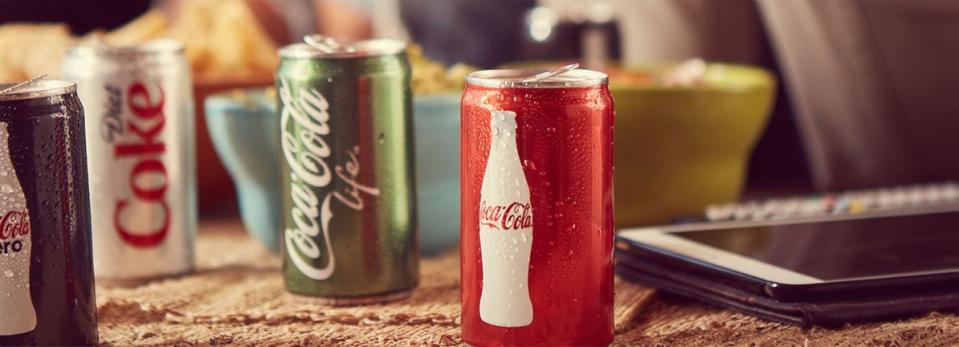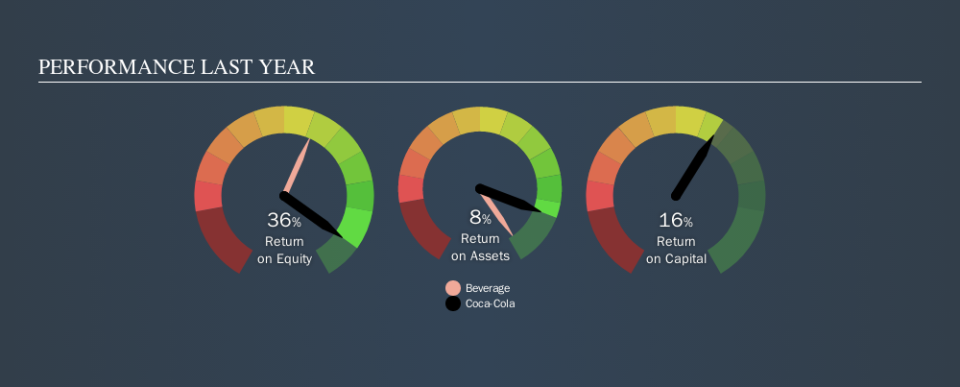Why The Coca-Cola Company’s (NYSE:KO) Return On Capital Employed Is Impressive

Today we are going to look at The Coca-Cola Company (NYSE:KO) to see whether it might be an attractive investment prospect. Specifically, we're going to calculate its Return On Capital Employed (ROCE), in the hopes of getting some insight into the business.
Firstly, we'll go over how we calculate ROCE. Second, we'll look at its ROCE compared to similar companies. Last but not least, we'll look at what impact its current liabilities have on its ROCE.
What is Return On Capital Employed (ROCE)?
ROCE measures the amount of pre-tax profits a company can generate from the capital employed in its business. In general, businesses with a higher ROCE are usually better quality. Ultimately, it is a useful but imperfect metric. Renowned investment researcher Michael Mauboussin has suggested that a high ROCE can indicate that 'one dollar invested in the company generates value of more than one dollar'.
How Do You Calculate Return On Capital Employed?
Analysts use this formula to calculate return on capital employed:
Return on Capital Employed = Earnings Before Interest and Tax (EBIT) ÷ (Total Assets - Current Liabilities)
Or for Coca-Cola:
0.16 = US$9.6b ÷ (US$90b - US$29b) (Based on the trailing twelve months to June 2019.)
Therefore, Coca-Cola has an ROCE of 16%.
See our latest analysis for Coca-Cola
Does Coca-Cola Have A Good ROCE?
ROCE can be useful when making comparisons, such as between similar companies. Coca-Cola's ROCE appears to be substantially greater than the 10% average in the Beverage industry. I think that's good to see, since it implies the company is better than other companies at making the most of its capital. Independently of how Coca-Cola compares to its industry, its ROCE in absolute terms appears decent, and the company may be worthy of closer investigation.
The image below shows how Coca-Cola's ROCE compares to its industry, and you can click it to see more detail on its past growth.
When considering ROCE, bear in mind that it reflects the past and does not necessarily predict the future. ROCE can be misleading for companies in cyclical industries, with returns looking impressive during the boom times, but very weak during the busts. ROCE is only a point-in-time measure. Since the future is so important for investors, you should check out our free report on analyst forecasts for Coca-Cola.
Coca-Cola's Current Liabilities And Their Impact On Its ROCE
Current liabilities are short term bills and invoices that need to be paid in 12 months or less. The ROCE equation subtracts current liabilities from capital employed, so a company with a lot of current liabilities appears to have less capital employed, and a higher ROCE than otherwise. To counteract this, we check if a company has high current liabilities, relative to its total assets.
Coca-Cola has total liabilities of US$29b and total assets of US$90b. As a result, its current liabilities are equal to approximately 33% of its total assets. Coca-Cola has a middling amount of current liabilities, increasing its ROCE somewhat.
Our Take On Coca-Cola's ROCE
While its ROCE looks good, it's worth remembering that the current liabilities are making the business look better. Coca-Cola looks strong on this analysis, but there are plenty of other companies that could be a good opportunity . Here is a free list of companies growing earnings rapidly.
There are plenty of other companies that have insiders buying up shares. You probably do not want to miss this free list of growing companies that insiders are buying.
We aim to bring you long-term focused research analysis driven by fundamental data. Note that our analysis may not factor in the latest price-sensitive company announcements or qualitative material.
If you spot an error that warrants correction, please contact the editor at editorial-team@simplywallst.com. This article by Simply Wall St is general in nature. It does not constitute a recommendation to buy or sell any stock, and does not take account of your objectives, or your financial situation. Simply Wall St has no position in the stocks mentioned. Thank you for reading.

 Yahoo Finance
Yahoo Finance 
